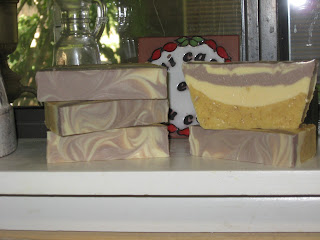There are several different kinds of Herbs you can buy to color your soaps.
You can add the Herbs to your soap batter or you can infuse them into an oil.
Here are some of the Herbs you can buy in powder form.
Orange Peel powder, Rose Hip powder, Alkanet Root powder, Kelp powder, and Turmeric Root powder.
You can infuse these herbs into oils such as; Olive Oil, Jojoba Oil, or Sunflower Oil.
I choose to infuse these Herb powders into Sunflower Oil.
For a strong infusion you want to use about 1oz of herb powder to 16oz of the oil of your choice.
You can set each jar in the sun for about 3 weeks to get a good infusion, or you can put the jars in a hot water bath.
If you choose a hot water bath:
You want to heat your water bath on low and keep it at a steady 140 - 150 degrees. You do not cover your jars with water! Just add enough water, about one inch below covers, and don't screw the covers on tightly.You don't want the jars to seal, you only want the bath to be hot enough to infuse the color from the herbs into the oils. Let your jars sit in this hot water bath (with heat on low) for about 2-3 hours, then shut off the heat and let the bath cool down.
The colors would be ready to use right away.
KK at Badanbody uses .33 ounces of colored oil to a 1lb of oil formula in her soaps.
Here are four herbs that I infused into Sunflower Oil in a hot water bath:
This is the color of Sunflower Oil. I put the jar next to each color infused oil so you could see the different shades after the infusion.
This is Alkanet Root Powder.
Alkanet Root will color your soap to a nice mauve, shades of lavender, and blue.
This one is Orange Peel Powder.
This herb will produce a pale orange yellow.
Rose Hip Powder.
This powder will produce a rosey tan. Rose Hip powder has skin healing properties.
Kelp Powder.
Kelp powder will produce shades of green.
If you leave some Kelp powder in your soap it can be a very mild exfoliant.
You can strain the oils so won't have any herb powder specks in your soap. But the herb powder will settle to the bottom of the jar, so if you are careful you can pour out the colored oil without the herb powder coming with it.
*If you do not want to infuse herb powders into oil you can also, at trace, put 1/2 tsp of herb powder into 1lb of soap, and mix well. Doing it this way you will get a speckled look.

















.jpg)



